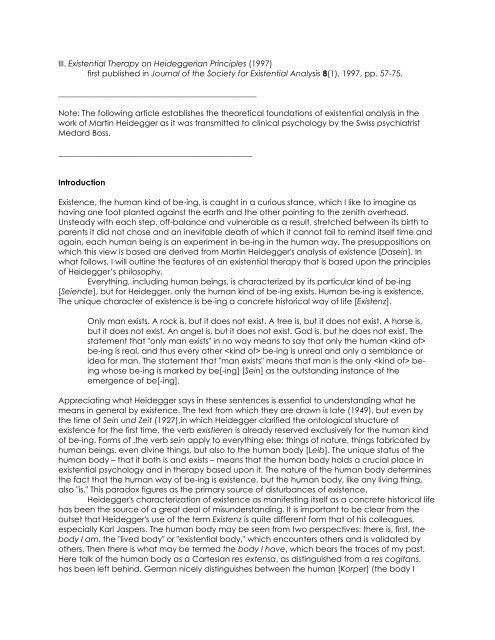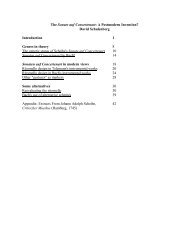SEVEN PAPERS ON EXISTENTIAL ANALYSIS ... - Wagner College
SEVEN PAPERS ON EXISTENTIAL ANALYSIS ... - Wagner College
SEVEN PAPERS ON EXISTENTIAL ANALYSIS ... - Wagner College
You also want an ePaper? Increase the reach of your titles
YUMPU automatically turns print PDFs into web optimized ePapers that Google loves.
III. Existential Therapy on Heideggerian Principles (1997)<br />
first published in Journal of the Society for Existential Analysis 8(1), 1997, pp. 57-75.<br />
_________________________________________________<br />
Note: The following article establishes the theoretical foundations of existential analysis in the<br />
work of Martin Heidegger as it was transmitted to clinical psychology by the Swiss psychiatrist<br />
Medard Boss.<br />
________________________________________________<br />
Introduction<br />
Existence, the human kind of be-ing, is caught in a curious stance, which I like to imagine as<br />
having one foot planted against the earth and the other pointing to the zenith overhead.<br />
Unsteady with each step, off-balance and vulnerable as a result, stretched between its birth to<br />
parents it did not chose and an inevitable death of which it cannot fail to remind itself time and<br />
again, each human being is an experiment in be-ing in the human way. The presuppositions on<br />
which this view is based are derived from Martin Heidegger's analysis of existence [Dasein]. In<br />
what follows, I will outline the features of an existential therapy that is based upon the principles<br />
of Heidegger’s philosophy.<br />
Everything, including human beings, is characterized by its particular kind of be-ing<br />
[Seiende], but for Heidegger, only the human kind of be-ing exists. Human be-ing is existence.<br />
The unique character of existence is be-ing a concrete historical way of life [Existenz].<br />
Only man exists. A rock is, but it does not exist. A tree is, but it does not exist. A horse is,<br />
but it does not exist. An angel is, but it does not exist. God is, but he does not exist. The<br />
statement that "only man exists" in no way means to say that only the human <br />
be-ing is real, and thus every other be-ing is unreal and only a semblance or<br />
idea for man. The statement that "man exists" means that man is the only being<br />
whose be-ing is marked by be[-ing] [Sein] as the outstanding instance of the<br />
emergence of be[-ing].<br />
Appreciating what Heidegger says in these sentences is essential to understanding what he<br />
means in general by existence. The text from which they are drawn is late (1949), but even by<br />
the time of Sein und Zeit (1927),in which Heidegger clarified the ontological structure of<br />
existence for the first time, the verb existieren is already reserved exclusively for the human kind<br />
of be-ing. Forms of .the verb sein apply to everything else: things of nature, things fabricated by<br />
human beings, even divine things, but also to the human body [Leib]. The unique status of the<br />
human body – that it both is and exists – means that the human body holds a crucial place in<br />
existential psychology and in therapy based upon it. The nature of the human body determines<br />
the fact that the human way of be-ing is existence, but the human body, like any living thing,<br />
also "is." This paradox figures as the primary source of disturbances of existence.<br />
Heidegger's characterization of existence as manifesting itself as a concrete historical life<br />
has been the source of a great deal of misunderstanding. It is important to be clear from the<br />
outset that Heidegger's use of the term Existenz is quite different form that of his colleagues,<br />
especially Karl Jaspers. The human body may be seen from two perspectives: there is, first, the<br />
body I am, the "lived body" or "existential body," which encounters others and is validated by<br />
others. Then there is what may be termed the body I have, which bears the traces of my past.<br />
Here talk of the human body as a Cartesian res extensa, as distinguished from a res cogitans,<br />
has been left behind. German nicely distinguishes between the human [Korper] (the body I















